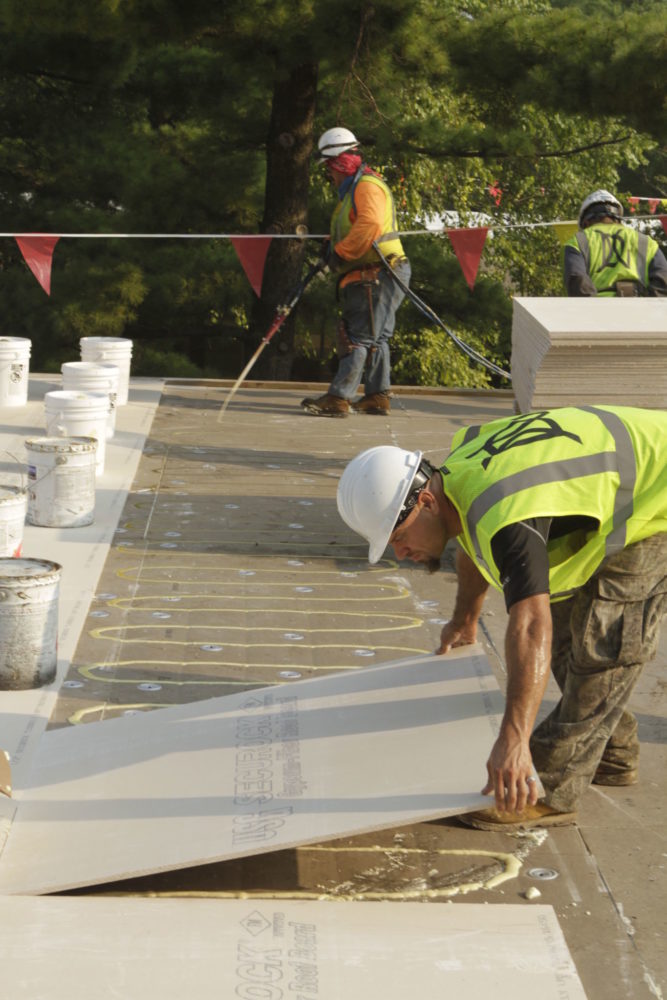
Photos courtesy USG
by Derrick Hutchinson
When designing a roofing assembly, many factors need to be considered. Performance attributes, product quality, aesthetics, price, and quantity must all be carefully examined. One key product often overlooked during this process is the cover board.
A cover board is a thin substrate to which a roof membrane is adhered—however, its use far exceeds that of a typical substrate. Cover boards also serve as critical components helping extend the life of a roof. For example, using a cover board minimizes the literal and figurative impact of hail. Hail damage on a roof without a cover board can easily pierce the insulation, which will increase the heat flow through it, thereby adding to the building’s energy costs.
Cover boards also serve as barriers protecting the roof (and its very flammable insulation) from external fire. Further, they help increase the wind uplift value of a roof assembly by providing a strong, high-performing layer of defense. However, strict adherence to the recommended fastener spacing is key to this wind uplift performance. This prevents potential damage that may occur during unfavorable weather.
Based on roof evaluations found in a global property insurance company Factory Mutual’s database, wind uplift study results show including a cover board helps increase a building’s wind uplift and fire performance. Cover boards can double the wind uplift of certain roof assemblies or enable them to achieve the same rating with fewer fasteners.
The National Roofing Contractors Association (NRCA) has endorsed the use of cover boards in all low-slope roofs due to the insulation’s negative attributes like facer delamination, powdering, shrinkage, cupping, and edge cavitation. Cover boards help support the insulation in the event of these failures. All these uses of cover boards provide added security and lower cost of ownership for the building.
Just as cover boards are used to protect against various potential threats, they come in a variety of compositions tailored to an array of applications. With so many options for cover boards, selecting the appropriate product may be challenging at first. By keeping in mind the desired result, the process becomes easier.
Different cover boards have different physical properties
There are many types of cover boards suitable for an assortment of applications. Each has features and benefits suitable for a desired result. In the following section, various materials are explored, all of which could also be used as a thermal barrier placed directly over the roof deck. In this application, the cover board provides a fire barrier in the case of an internal fire, significantly increasing the time required to melt the insulation, which adds fuel to the flames. The cover board also serves as a substrate and vapor retarder in this application.
Gypsum fiber
A fiber-reinforced, uniform-composition cover board that can be used in most roof applications, gypsum fiber products typically provide unmatched wind uplift and hail performance (higher than any other cover board), with no risk of facer delamination. This product also protects against moisture and mold. This product costs approximately 50 cents per square foot.
Gypsum
A gypsum core and a glass-mat facer also provide protection from moisture and mold. This product is usually available with a primed or unprimed glass facer. The primed facer allows for adhesion of the membrane, while an unprimed facer is typically used for a mechanically attached single-ply application that does not require adherence to the membrane. This product costs approximately 50 cents per square foot.
Cement
Typically cementitious-based with a reinforcement mesh for added strength, these products tend to be water-durable and will not rot, warp, delaminate, or disintegrate. They may also be noncombustible, providing a suitable fire barrier for any roof assembly or parapet wall. This product costs approximately 50 cents per square foot.
Wood fiber
Often made from wood fiber and bonded together with a resin, these cover boards are typically used in hot-mop and torched applications. This product costs approximately 30 cents per square foot.
High-density insulation
Fairly new to the market, high-density insulation boards are typically composed of a compressed polyisocyanurate (polyiso) core with a coated glass-mat facer—this means they are generally lightweight products. This product costs approximately 50 cents per square foot.
Perlite
These cover boards consist of expanded perlite, cellulose binder, and mineral aggregate. They are typically used in hot-mop and torched applications. This product costs approximately 30 cents per square foot.
Asphaltic
Made of a mineral-fortified, asphalt-based core with fiberglass facers, these boards are typically employed in asphaltic roof assemblies. This product costs approximately 30 cents per square foot.
Mineral fiber board
These boards, which consist of stone wool or mineral fiber, provide good sound properties. They are typically used in asphaltic roof systems. This product costs approximately 30 cents per square foot.




